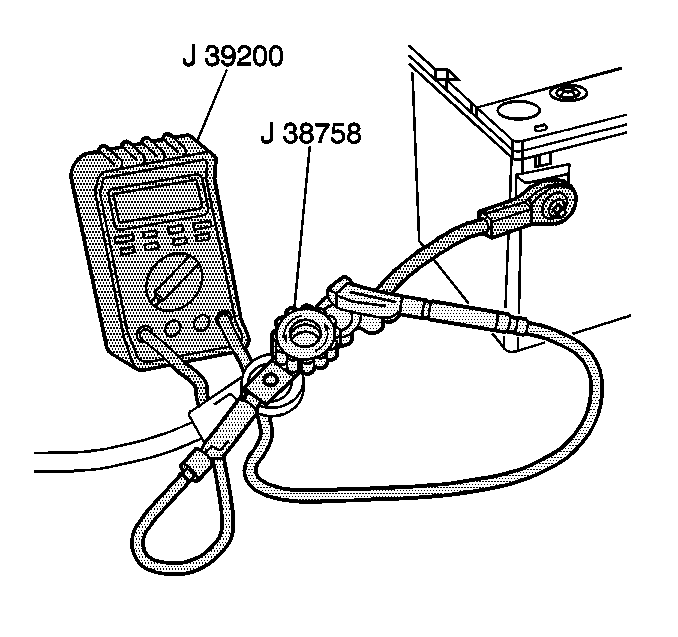Current Drain Test
If the vehicle exhibits a low or dead battery after an overnight period,
or discharges over a period of 2 or 3 days and no cause is evident, the electrical
system should be inspected for an excessive electrical drain. The cause
of the excessive unintended current drain is referred to as a parasitic
load. One or more on-board solid-state control modules, such as the PCM,
may at some time exhibit a failure mode that causes a high parasitic
drain on the vehicle's battery. Another source of parasitic drain could
be an unnoticed load such as a glove box lamp which remains on at all
times.
Testing for a parasitic drain requires a special tool because the excessive
current drain may not occur after the battery is disconnected in order to
install an ammeter. Cycling the ignition key to the RUN and then to
the OFF position may cause such a drain to recur, but there may be drains
that will not recur unless the vehicle systems are reactivated in a road
test. The ignition switch must not be rotated to the START position
with an ammeter installed between the battery terminal and the battery
cable, but the special tool enables the vehicle to be driven in order
to assure that all vehicle systems are ready for testing.
Tools Required
| • | J 39200 Digital
Multimeter, or equivalent |
Caution: Unless directed otherwise, the ignition and start switch must be in the OFF or LOCK position, and all electrical loads must be OFF before servicing
any electrical component. Disconnect the negative battery cable to prevent an electrical spark should a tool or equipment come in contact with an exposed electrical terminal. Failure to follow these precautions may result in personal injury and/or damage to
the vehicle or its components.
- Disconnect
the negative battery cable.
- Ensure that the following conditions are met:
| • | The ignition switch is in LOCK |
| • | The electrical accessories are turned OFF |

- Install the male end of
the J 38758
to the negative
battery terminal.
- Turn the J 38758
test switch to the OFF position.
- Connect the negative battery cable to the female end of the J 38758
test switch.
- Turn theJ 38758
test switch to the ON position.
Notice: Do not turn the parasitic draw test switch to the OFF position with
the engine running. Damage will occur to the vehicle's electrical system.
- Road test the vehicle while activating all the accessories, such as
the radio and the air conditioning.
- Turn the ignition switch to the LOCK position and remove the key.
Turn off all electrical accessories. Close the doors of the vehicle to prevent
a current draw for the interior courtesy lamps.
- In order to avoid a false reading, wait 15 minutes for
all components to power down before continuing this test .
- Before connecting the ammeter, use the following procedure in
order to determine whether or not the current drain is less than 10 amps:
| 10.1. | Connect a jumper wire with an in-line 10-amp fuse or circuit breaker
to the terminals of the J 38758
test switch. |
| 10.2. | Turn the J 38758
test
switch to the OFF position. |
- If the fuse in the jumper wire does not blow, turn the J 38758
test switch ON, set the J 39200
to the 10-amp scale and connect the digital multimeter to the J 38758
test switch, and then
remove the jumper wire. If current is greater than 10 amps, use a test
lamp instead of an ammeter.
Important: Always turn the J 38758
test switch to the ON position between tests. The ON position allows current
to flow through the battery cable. If the test switch is left in the
OFF position between tests, the ammeter could be damaged due to accidental
overloading. An example of an accidental high current load would be
opening the door of the vehicle (to change a fuse), and turning on
the interior courtesy lamps. If the test switch is in the OFF position
when the door is opened, all current for the lamps would flow through
the ammeter, and the meter may be damaged if it is set in the low range.
- Remove the fuses one at a time, and install each one after the fuse
is tested. Perform the following steps each time a fuse is removed:
| 12.1. | Turn the test switch to the OFF position. This forces all current
to flow through the meter. |
| 12.2. | Wait at least 60 seconds. Verify the current reading. If
the reading is at or below 2 amps, turn the test switch to the ON position
in order to maintain continuity in the electrical system while switching
to the 2 amp scale for a more accurate reading. Turn the test
switch to the ON position between tests. |
| 12.3. | The parasitic draw is typically under 60 milliamperes.
If the ammeter drops to an acceptable reading after a fuse is removed, the
circuit causing the drain has been identified. |
| 12.4. | Install the fuse for the circuit which is causing the excessive
drain. Using the schematic as a guide, disconnect the components of the faulty
circuit one at a time until the faulty component is located. If the fuse
for the interior courtesy lamps is removed, the door of the vehicle
can be open during the test procedure without damaging the ammeter
while it is set in the low range. |
- When the cause of excessive current draw has been located and
repaired, remove the current drain test switch and connect the negative battery
cable to the negative battery terminal.

